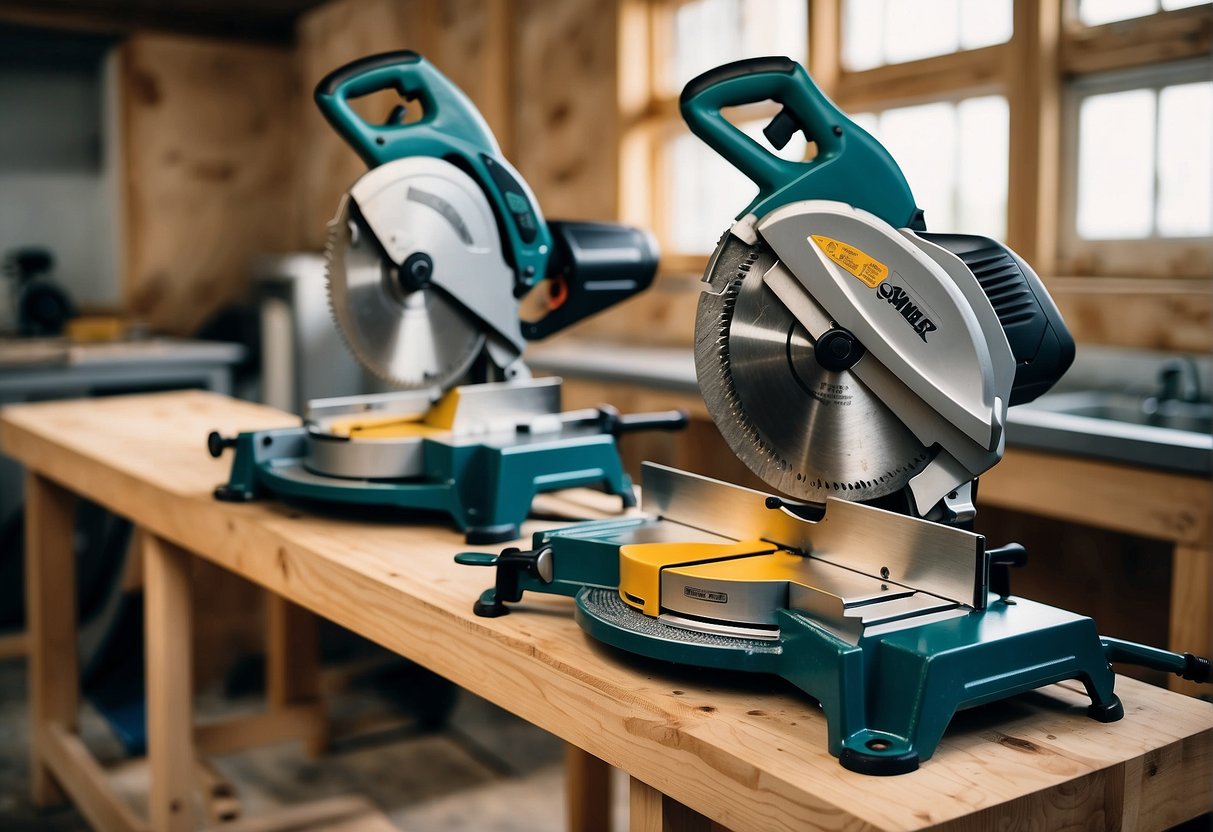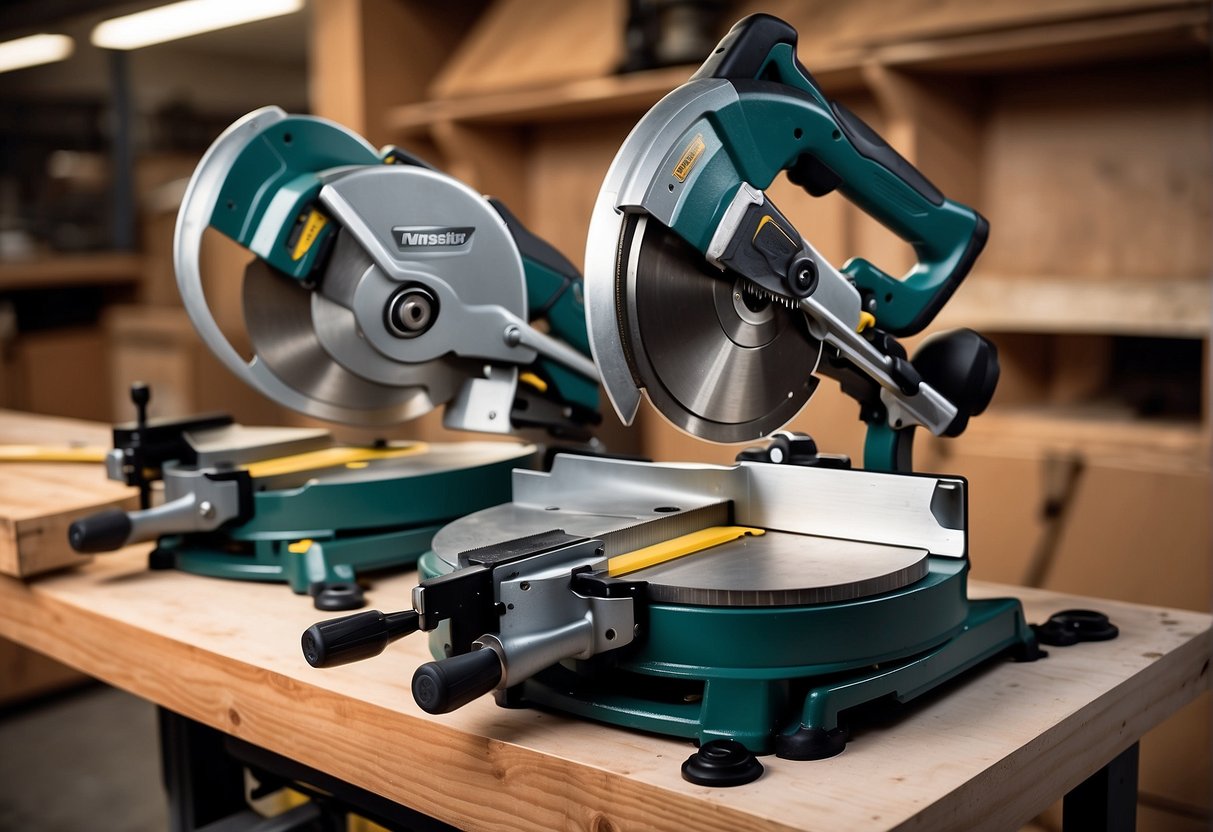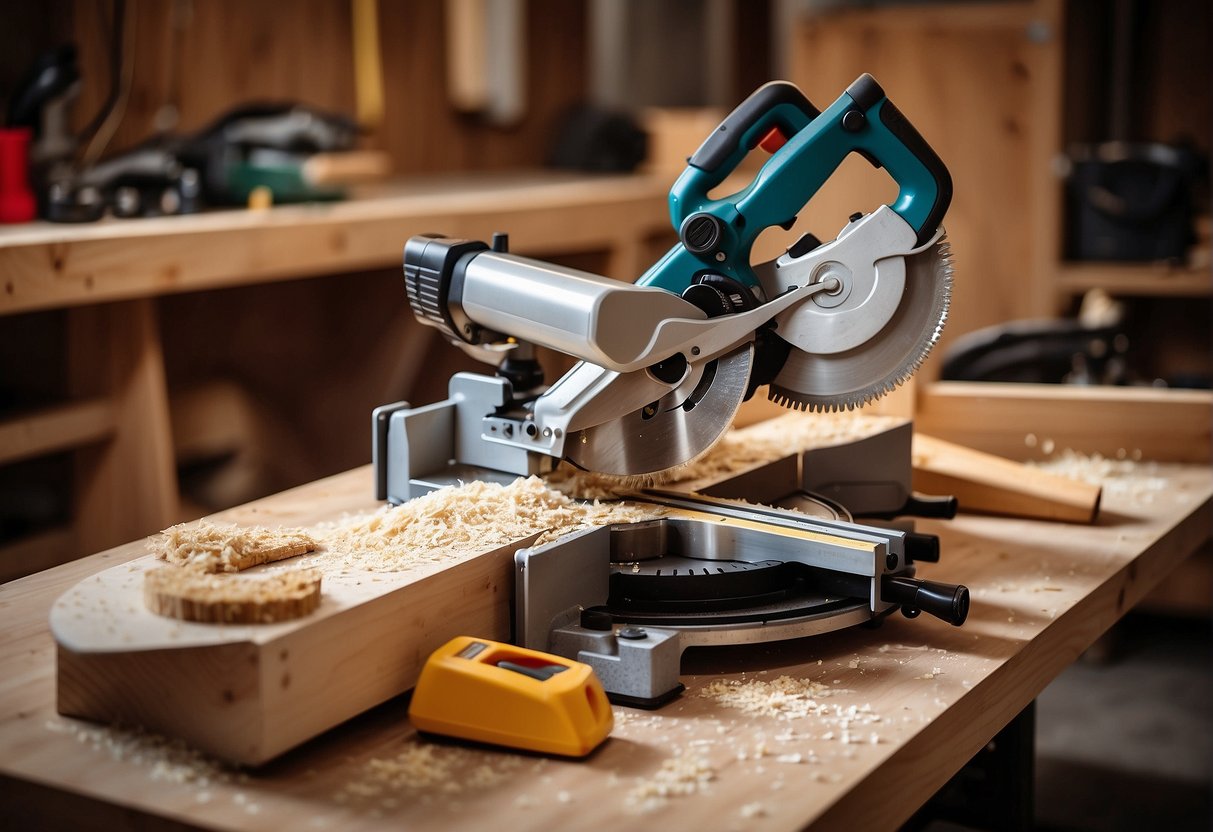When it comes to woodworking, choosing the right tools is crucial to achieving the desired outcome. One of the most important tools in a woodworker’s arsenal is a miter saw. Miter saws come in different sizes, with 10-inch and 12-inch models being the most common. As a woodworker, I have used both types of miter saws and have discovered some key differences between them.
Understanding miter saws is essential to choosing the right one for your project. A miter saw is a power tool used to make accurate crosscuts and miters in wood, metal, and other materials. It is an essential tool for any woodworker, carpenter, or DIY enthusiast. Miter saws come in different sizes, with the most common being the 10-inch and 12-inch models. The size of the saw blade determines the size of the material that can be cut.
Key Takeaways
- Choosing the right miter saw is crucial for achieving the desired outcome in woodworking projects.
- 10-inch and 12-inch miter saws are the most common sizes, with the size of the saw blade determining the size of the material that can be cut.
- 10-inch miter saws are more affordable and easier to find than 12-inch saws, while 12-inch saws have a greater cutting capacity and are more suitable for larger projects.
Understanding Miter Saws
As a woodworking enthusiast, I have found miter saws to be an essential tool in my workshop. They are versatile and can make angled cuts with precision. Miter saws come in different types, sizes, and capacities, making it essential to understand their key components and functions.
Types of Miter Saws
There are three main types of miter saws: standard miter saws, compound miter saws, and sliding compound miter saws. Standard miter saws are the most basic type of miter saw. They can make angled cuts up to 45 degrees in one direction. Compound miter saws, on the other hand, can make angled cuts in two directions. They can tilt the blade to make bevel cuts, which are angled cuts that are not 90 degrees. Sliding compound miter saws can slide back and forth, allowing them to make wider cuts.
Key Components and Functions
Miter saws have several key components that are essential to their function. The blade is the most crucial part of the saw, and it comes in different sizes. The most common blade sizes are 10 inches and 12 inches. The blade size determines the depth of the cut that the saw can make. The motor is another essential component of the saw. It powers the blade and determines the saw’s RPM. The higher the RPM, the faster the blade will spin.
Sliding miter saws have an additional component called the sliding mechanism. It allows the saw to slide back and forth, making wider cuts. The capacity of the saw refers to the maximum width of the board that the saw can cut. It is essential to choose a saw with a capacity that matches your needs.
In conclusion, understanding the different types, key components, and functions of miter saws is crucial in choosing the right saw for your woodworking needs. Whether you need a basic saw for simple angled cuts or a sliding compound saw for wider cuts, knowing the features and capabilities of each saw will help you make an informed decision.
Comparing 10-Inch and 12-Inch Miter Saws
When it comes to choosing between a 10-inch and a 12-inch miter saw, there are several factors to consider. In this section, I will compare the two saws in terms of blade size and cutting capacity, motor power and performance, as well as price and availability.
Blade Size and Cutting Capacity
The most significant distinction between a 10-inch and a 12-inch miter saw is their blade size and cutting capacity. The 12-inch saw typically has a greater cross-cutting capacity than the 10-inch saw, allowing for more extensive and efficient projects. The 12-inch blade can handle wider boards and longer cuts than the 10-inch blade, which is limited to cutting into roughly 4- or 5-inch thick wood. However, for most woodworking projects, the 10-inch blade will work just fine.
Motor Power and Performance
Another factor to consider when choosing between a 10-inch and a 12-inch miter saw is motor power and performance. Generally, 12-inch saws have more powerful motors than 10-inch saws, which allows them to cut through thicker and harder materials with ease. However, this also means that 12-inch saws are typically more expensive than their 10-inch counterparts.
Price and Availability
Price and availability are also important factors to consider when choosing between a 10-inch and a 12-inch miter saw. 10-inch saws are generally more affordable and widely available than 12-inch saws. This makes them a great choice for beginners or those on a budget. However, if you need a saw with a larger cutting capacity and more power, a 12-inch saw may be worth the investment.
In conclusion, both 10-inch and 12-inch miter saws have their advantages and disadvantages. The choice ultimately depends on your specific needs and budget. If you are a beginner or working on smaller projects, a 10-inch saw may be the best choice for you. However, if you need a saw with a larger cutting capacity and more power, a 12-inch saw may be the better option.
Advantages and Limitations
When it comes to choosing between a 10-inch and a 12-inch miter saw, there are several factors to consider. In this section, I will discuss the benefits and limitations of both saws to help you make an informed decision.
Benefits of 10-Inch Miter Saws
One of the primary advantages of a 10-inch miter saw is its affordability and availability. As mentioned in Handyman’s World, a typical 10-inch miter saw will cost you as little as $100 while a 12-inch could cost twice as much. Moreover, 10-inch blades are more common than 12-inch blades, making them easier to find.
Another benefit of a 10-inch miter saw is its portability. A smaller blade size means a lighter saw, making it easier to move around the workshop or job site. Additionally, a 10-inch blade spins faster than a 12-inch blade, resulting in a smoother and more efficient cut.
Strengths of 12-Inch Miter Saws
A 12-inch miter saw, on the other hand, offers several advantages over its smaller counterpart. As Updweller notes, a 12-inch saw has a more robust and durable build, which makes it ideal for heavy-duty projects. Additionally, a 12-inch blade has more teeth than a 10-inch blade, resulting in a more precise and accurate cut.
Another strength of a 12-inch miter saw is its cutting capacity. As Tyler Brown Woodworking points out, a 12-inch saw can handle thicker and denser materials, making it ideal for larger woodworking projects.
Considerations for Choosing
When choosing between a 10-inch and a 12-inch miter saw, there are several factors to consider. As I discussed earlier, affordability and portability are some of the benefits of a 10-inch miter saw. However, if you are working on heavy-duty projects that require more precision and accuracy, a 12-inch miter saw may be the better choice.
Another consideration is the type of projects you will be working on. If you are a DIY enthusiast or a beginner woodworker, a 10-inch miter saw may be sufficient for your needs. However, if you are a professional woodworker or contractor, a 12-inch miter saw may be a better investment.
In conclusion, both 10-inch and 12-inch miter saws have their advantages and limitations. It is essential to consider your specific needs and requirements before making a purchase.
Applications in Woodworking Projects
As a woodworker, choosing between a 10-inch and 12-inch miter saw is an important decision that can affect the outcome of your project. The right saw for you will depend on the type of woodworking project you are working on, as well as your level of experience. In this section, I will discuss the applications of both saws in woodworking projects.
Small-Scale and DIY Projects
If you are a DIY enthusiast, a 10-inch miter saw may be the best option for you. This saw is perfect for small-scale projects, such as making picture frames, cutting baseboards, or crown molding. It is also ideal for making angled cuts on trim and molding.
A 10-inch miter saw is also suitable for cutting plywood and other thin materials. However, if you are working with thicker materials, such as lumber or decking, a 12-inch miter saw may be a better option.
Professional and Larger Tasks
For professional woodworkers or larger tasks, a 12-inch miter saw is the better choice. This saw has a greater cutting capacity, making it ideal for cutting thicker materials, such as framing lumber or decking. It is also suitable for making angled cuts on crown molding and baseboards.
A 12-inch miter saw is also more accurate than a 10-inch saw, making it ideal for fine woodworking projects. However, it is also more expensive than a 10-inch saw, so it may not be the best choice for DIY enthusiasts or hobbyists.
In summary, the choice between a 10-inch and 12-inch miter saw will depend on the type of woodworking project you are working on. A 10-inch saw is perfect for small-scale projects and DIY enthusiasts, while a 12-inch saw is more suitable for professional woodworkers or larger tasks.
Practical Tips for Users
As someone who has used both 10 and 12-inch miter saws for various projects, I have some practical tips to share.
Firstly, consider the size and portability of the saw. If you work on a lot of small projects or need to move the saw around frequently, a 10-inch saw might be a better option as it is often more compact and lightweight compared to a 12-inch saw. However, if you need to tackle larger tasks and have the space to accommodate a heavier saw, a 12-inch saw might be a better choice.
Another factor to consider is your budget. In general, 10-inch saws tend to be more budget-friendly compared to 12-inch saws. However, keep in mind that a higher price tag often means better quality and features.
When it comes to ease of use and control, both 10 and 12-inch saws can be user-friendly if you choose a model with good features and design. Look for features such as laser guides, easy-to-adjust bevels, and comfortable handles to ensure better control and movement.
If you frequently work with trim boards or other small pieces of wood, a 10-inch saw might be a better option as it can provide more precision and accuracy. However, if you need to tackle larger pieces of wood, a 12-inch saw might be necessary.
Overall, the choice between a 10 and 12-inch miter saw ultimately depends on your specific needs and preferences. Consider factors such as the size and portability of the saw, your budget, and the types of projects you typically work on to make an informed decision.
Frequently Asked Questions
What is the maximum cutting capacity of a 12-inch sliding miter saw?
A 12-inch sliding miter saw typically has a larger cutting capacity than a 10-inch model, making it ideal for cutting wider boards and longer cuts. The maximum cutting capacity of a 12-inch sliding miter saw can vary depending on the specific model, but it can generally handle cuts up to 16 inches wide and 4 inches thick.
How does the DEWALT brand compare in the 10-inch and 12-inch miter saw categories?
DEWALT is a well-known brand in the power tool industry, and they offer a range of miter saws in both the 10-inch and 12-inch categories. Their 12-inch sliding compound miter saws are particularly popular among professionals and DIY enthusiasts, as they offer a large cutting capacity and precise cuts. Their 10-inch miter saws are also highly rated, and are known for their accuracy and ease of use.
What are the advantages of using a 10-inch miter saw over a 12-inch model for woodworking projects?
A 10-inch miter saw can be a great choice for woodworking projects that don’t require cutting large boards or thick lumber. One advantage of using a 10-inch miter saw is that it is generally more affordable than a 12-inch model. Additionally, a 10-inch miter saw is usually lighter and more portable than a 12-inch model, making it easier to move around your workshop or job site.
Can a 10-inch miter saw efficiently cut through a 4×4 piece of lumber?
While a 10-inch miter saw can technically cut through a 4×4 piece of lumber, it may not be the most efficient or precise option. It’s important to note that a 10-inch miter saw typically has a smaller cutting capacity than a 12-inch model, which means that it may struggle to make clean, accurate cuts on larger pieces of lumber.
What size of lumber can a 10-inch sliding miter saw handle without compromising precision?
A 10-inch sliding miter saw can typically handle lumber up to 2×6 in size without compromising precision. However, it’s important to keep in mind that the cutting capacity of a miter saw can vary depending on the specific model, so it’s always a good idea to check the manufacturer’s specifications before making any cuts.
What are some of the top-rated 12-inch sliding compound miter saws currently on the market?
Some of the top-rated 12-inch sliding compound miter saws on the market include the DEWALT DWS780, the Bosch CM12SD, and the Makita LS1219L. These saws are known for their large cutting capacity, precise cuts, and durability. However, it’s important to note that the best miter saw for you will depend on your specific needs and budget.

Hi, I’m Sal Muller of Tooltrip.com. My DIY experience led me to understand essential power tools for home projects. Tooltrip.com guides enthusiasts and professionals in choosing right tools for any job. I provide concise top tool reviews for easier, efficient DIY.





